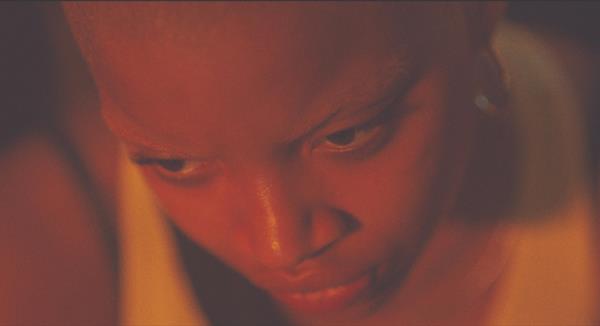Watching Goldie, I was struck by how many films, and how many excellent ones, in the past few years have in some way featured protagonists who attempt to live outside of society, often with disastrous or at least unsuccessful results: Leave No Trace, Shoplifters, Good Time, The Florida Project, The Strange Ones, Border, and Captain Fantastic. To me, this seems an unusual number, and I’m sure that I have missed a few. Perhaps there is something about our current moment that has attracted some of our best and most promising filmmakers to muse on the yearning to escape and live in a world of our own devising. Perhaps the recent glut of good films on this subject is pure coincidence. Goldie belongs in their company.
Goldie tells a fairly familiar story. Goldie, 18, lives in a shelter in the Bronx with her mother and two younger sisters and dreams of fame. Her first stepping stone is to submit an audition tape to a local and successful rapper to dance in his music video, for which she is accepted. And yet, in a short span of time, she loses her job at a department store and the police arrest her mother, leaving her sisters no option other than Children’s Services. Goldie, however, is determined both to keep her family together and make it to her music video shoot, wearing a $300 canary yellow coat she is convinced she must wear to look her best for her big break. The film follows her as she shuffles her younger siblings between temporary living situations, tries to find a way to get the $300, and, for the time being, evade child services.
Goldie is gloriously evocative of place and filmed in a style sometimes playful in the manner of the French New Wave or the Spike Lee of Do the Right Thing. The titles of chapters are announced by her little sisters and appear on the screen in messy, colorful letters, and the characters’ actions feel incredibly spontaneous, as though occurring just barely in time for the filmmaker to record them. Yet the film is also sober and troubling as Goldie looks for a place for her sisters to stay and a way to get money. She finds herself in increasingly precarious and uncomfortable situations, often with those who attempt to manipulate her and whom she often succeeds in manipulating. Walking out of the theater after Goldie, the Bronx, sweltering in summer heat, lingers powerfully in the mind.
The film’s true marvel might be Goldie herself, played by the model Slick Woods. On paper, Goldie is very simple—she seems to want just one thing, and her journey seems to be a straightforward attempt to achieve that. As played by Woods and scripted by director Sam de Jong, Goldie emerges as much more complex. She wants several things but is not yet capable of realizing how contradictory they are. She tells her sisters, and ostensibly also herself, that the money she will make from the music video will be enough to get them a home, but it’s compellingly unclear whether Goldie is acting primarily out of self-interest or not. In spite of the difficulty of the lessons she learns, the film is enlivening, as Goldie is so full of spirit and invincibility. Woods plays her with fierce ebullience in a performance that is singular and affecting.
For some viewers, the plot will feel too predictable, and this is not the first film that de Jong has made about a dreamer whose hopeful spirit is at odds with a harsh environment (2015’s Prince). Others will feel that it was executed in such a way as to make the familiar unique. I don’t know where it holds up among the films I listed earlier, some of which I am convinced are great, but it is certainly worth festivalgoer’s attention.
Sonejuhi Sinha’s Stray Dolls also features characters living on the margins, breaking the rules, and, in this case, the law, in an attempt to achieve the lives they desire. As in Goldie, the attempts are ill-fated, and it ruins nothing to reveal this. However, Goldie ends on a note of redemption, whereas the characters of Stray Dolls find themselves making choices that are more likely to ruin their lives completely. Unsettling and fast-paced, Stray Dolls examines the dark side of the American Dream, sometimes with riveting results.
Riz (Geetanjali Thapa) has traveled to America from India, where she survived on crime out of necessity, but she vows to do better in the States, where she hopes to raise enough money to bring the rest of her family. No such luck. She lands in an upstate New York motel run by Una (Cynthia Nixon), an Eastern European woman who gives Riz the opportunity to work as a housekeeper and suggests that she might be able to get her an American passport (though we see Una shred Riz’s Indian passport early on).
This motel, it turns out, is a home for dangerous derelicts, and Riz ends up the roommate of Dallas (Olivia DeJonge), a young, volatile American runaway who is willing to descend to drug trafficking to escape the motel and achieve her goal of running a nail salon. Against her will, Riz is roped into Dallas’s plans, and she turns out to me much more of an adept hand at crime than Dallas. As their choices become increasingly extreme, their relationship turns more complicated, even romantic, while their lives unravel.
Stray Dolls is nothing if not difficult to take one’s eyes off of. Throughout there is such a sense of danger that we feel almost as if, were we to look away, the characters might be in an even more precarious situation. Sinha has an eye for atmosphere, and the strongest aspects of the film are the cuts to evocative images, such as a washing machine constantly turning, and the rich and incessant soundscape. The characters are played convincingly, and several of the most powerful scenes are mostly wordless, including a rapturous sequence in which Riz and Dallas dance together after a robbery. Though the high stakes make it hard to look away, the film is strongest when Sinha succumbs to the pull of the imagery and the movement of bodies.
As in Goldie, some viewers will probably find the plot predictable. At times, the dialogue is a little obvious, and there are a few overstated gestures regarding its themes—lines of dialogue referring specifically to the American Dream and images of Trump declaiming his usual invective, for instance. The hopelessness of the American Dream is so clearly embodied by the plot that referring to it even a little bit feels like overkill. That being said, there is enough that is exciting in Stray Dolls to signal the arrival of a director to watch.








The movie Stray Dolls (2019) was good. I enjoy it, but it was not 5 star movie.